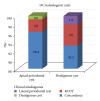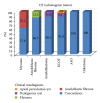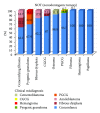Diagnostic concordance characteristics of oral cavity lesions
- PMID: 24453906
- PMCID: PMC3886281
- DOI: 10.1155/2013/785929
Diagnostic concordance characteristics of oral cavity lesions
Abstract
Purpose: The objective of this study was to evaluate the diagnostic concordance characteristics of oral cavity lesions by comparing the clinical diagnosis of the lesions with the histopathologic diagnosis.
Material and method: A retrospective analysis was conducted on the patients, who were admitted with oral cavity pathology and underwent biopsy procedure between 2007 and 2011. The oral cavity lesions were classified into 6 different groups as odontogenic cysts, nonodontogenic cysts, odontogenic tumors, nonodontogenic tumors, malignant tumors, and precancerous lesions in accordance with the 2005 WHO classification. The diagnoses were also recategorized into 3 groups expressing prognostic implications as benign, precancerous, and malignant. The initial clinical diagnoses were compared with the histopathologic diagnoses. Data were analyzed statistically.
Results: A total of 2718 cases were included. Histopathologic diagnosis did not match the clinical diagnosis in 6.7% of the cases. Nonodontogenic tumors and malignant tumors had the highest misdiagnosis rates (11.5% and 9%, resp.), followed by odontogenic tumors (7.7%), precancerous lesions (6.9%), and odontogenic cysts (4.4%). Clinicians were excelled in diagnosis of benign and precancerous lesions in clinical setting.
Conclusion: The detailed discordance characteristics for each specific lesion should be considered during oral pathology practice to provide early detection without delay.
Figures





Similar articles
-
Non-oncologic imaging of the oral cavity and jaws.Otolaryngol Clin North Am. 2008 Feb;41(1):103-37, vi. doi: 10.1016/j.otc.2007.10.009. Otolaryngol Clin North Am. 2008. PMID: 18261528 Review.
-
[Diagnosis, differential diagnosis and prognosis of odontogenic jaw cysts].Pathologe. 1980 Feb;1(2):63-70. Pathologe. 1980. PMID: 7208435 German. No abstract available.
-
Benign tumors and tumor-like lesions of the oral cavity and jaws: An analysis of 709 cases.Niger J Clin Pract. 2017 Nov;20(11):1448-1454. doi: 10.4103/1119-3077.187309. Niger J Clin Pract. 2017. PMID: 29303131
-
Tumors, cysts and allied lesions of the jaws and oral mucosa in Lagos, Nigeria, 1969-74.Int J Oral Surg. 1975 Dec;4(6):219-24. doi: 10.1016/s0300-9785(75)80038-x. Int J Oral Surg. 1975. PMID: 815183
-
A survey of 4478 biopsy specimens of oral lesions.J Pierre Fauchard Acad. 1994 Dec;8(4):143-7. J Pierre Fauchard Acad. 1994. PMID: 9855838 Review.
Cited by
-
Evaluating the Harmony Between Clinical Observations and Pathological Findings in Oral Soft Tissue Lesions: A Two-Decade Retrospective Study of Diagnostic Consistency.J Maxillofac Oral Surg. 2025 Feb;24(1):24-29. doi: 10.1007/s12663-025-02447-x. Epub 2025 Jan 14. J Maxillofac Oral Surg. 2025. PMID: 39902451
-
A Retrospective Analysis of Concordance Between Clinical and Histopathologic Diagnoses and Completeness of Oral Biopsy Forms at a Tertiary Dental Hospital in Eastern Nepal.Int J Dent. 2024 Oct 3;2024:2528353. doi: 10.1155/2024/2528353. eCollection 2024. Int J Dent. 2024. PMID: 39391532 Free PMC article.
-
The Agreement Rate between Radiographic Interpretation and Histopathologic Diagnosis of Jaw Lesions.Radiol Res Pract. 2019 Mar 4;2019:4056359. doi: 10.1155/2019/4056359. eCollection 2019. Radiol Res Pract. 2019. PMID: 30949367 Free PMC article.
-
Concordance Between Clinical and Histopathological Diagnoses of Oral and Maxillofacial Lesions in Thailand: A 20-Year Retrospective Study.J Clin Exp Dent. 2025 Jul 1;17(7):e834-e839. doi: 10.4317/jced.62771. eCollection 2025 Jul. J Clin Exp Dent. 2025. PMID: 40823103 Free PMC article.
-
Incidence of reactive hyperplastic lesions in the oral cavity: a 10 year retrospective study in Santa Catarina, Brazil.Braz J Otorhinolaryngol. 2019 Jul-Aug;85(4):399-407. doi: 10.1016/j.bjorl.2018.03.006. Epub 2018 Apr 17. Braz J Otorhinolaryngol. 2019. PMID: 29705120 Free PMC article.
References
-
- Regezi JA. Odontogenic cysts, odontogenic tumors, fibroosseous, and giant cell lesions of the jaws. Modern Pathology. 2002;15(3):331–341. - PubMed
-
- Patel KJ, De Silva HL, Tong DC, Love RM. Concordance between clinical and histopathologic diagnoses of oral mucosal lesions. Journal of Oral and Maxillofacial Surgery. 2011;69(1):125–133. - PubMed
-
- Sciubba JJ. Oral cancer: the importance of early diagnosis and treatment. American Journal of Clinical Dermatology. 2001;2(4):239–251. - PubMed
-
- Luo HY, Li TJ. Odontogenic tumors: a study of 1309 cases in a Chinese population. Oral Oncology. 2009;45(8):706–711. - PubMed
Publication types
MeSH terms
LinkOut - more resources
Full Text Sources
Other Literature Sources
Medical

